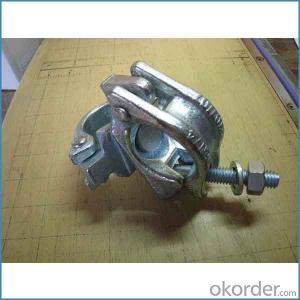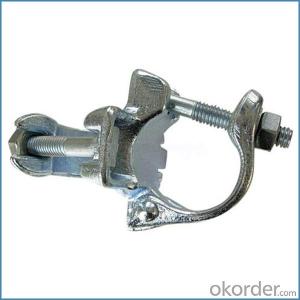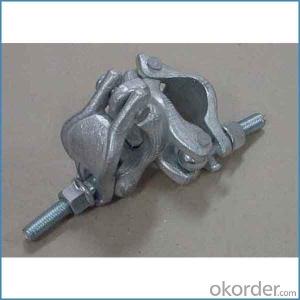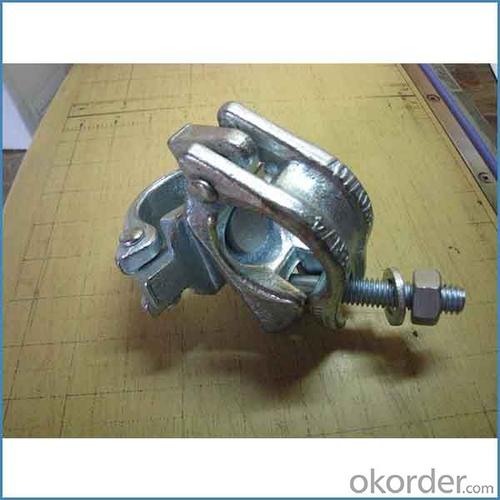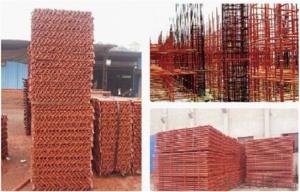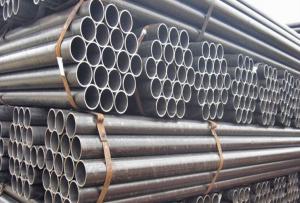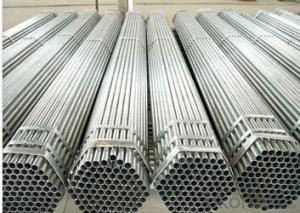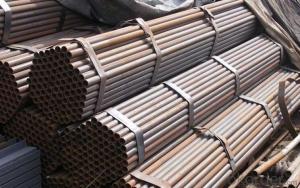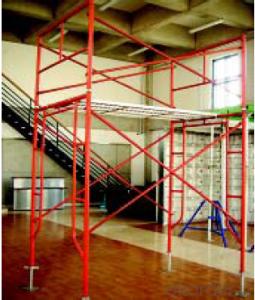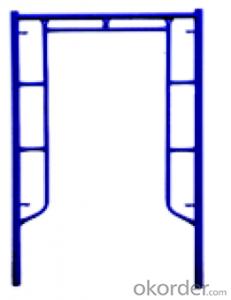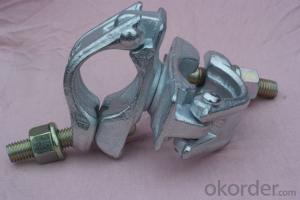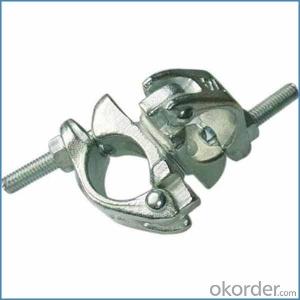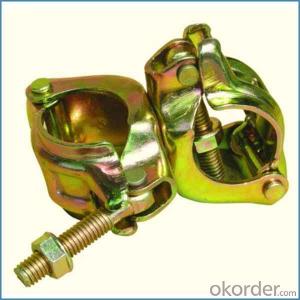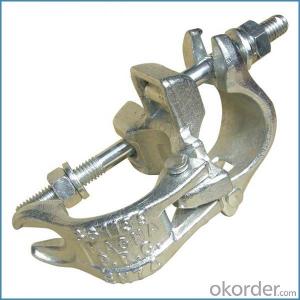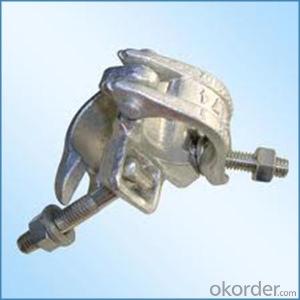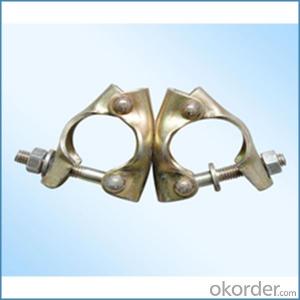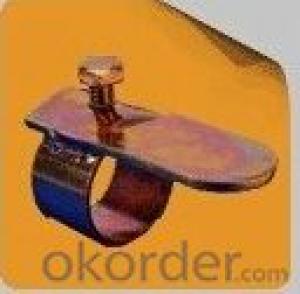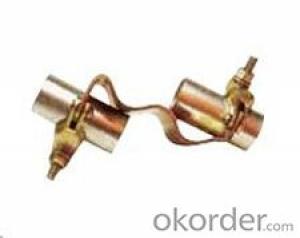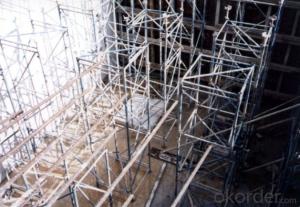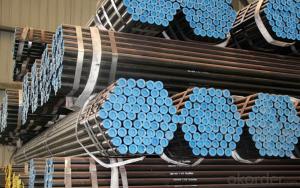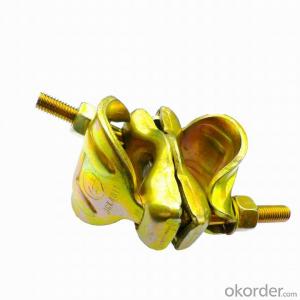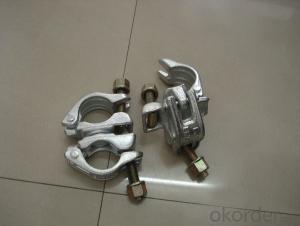British Swivel Coupler British Type for Sale
- Loading Port:
- Tianjin
- Payment Terms:
- TT OR LC
- Min Order Qty:
- 100 kg
- Supply Capability:
- 100000 kg/month
OKorder Service Pledge
OKorder Financial Service
You Might Also Like
British Swivel Coupler British Type for Sale
Description
1.The scaffolding coupler is always used to connect the steel pipe as scaffolding system.
2.The often used coupler is swivel coupler and righ angle coupler .
3.We can provide types of scaffolding coupler according to your requirement.
4.Couoler can fix the 48.3mm scaffolding steel pipe tightly and make the whole scaffolding system more steadily.
5.Material:Q235 steel
6.Overall Size:48.3mm*48.3mm
7.Surface Finish: Galvanized/ Painted
8.Standard:BS1139,EN74
9.Package:25pcs/bag
10.Manufactuering as per customer requirements

Feature
(1)Excellent Anti-Breaking—Cold Pressed Steel
(2)Outstanding Resistance Deformation
(3)Strong Anti-Dropping Ability
(4)Longtime USe
(5)Qualtity Guaranteed
(6)OEM Service
Photo
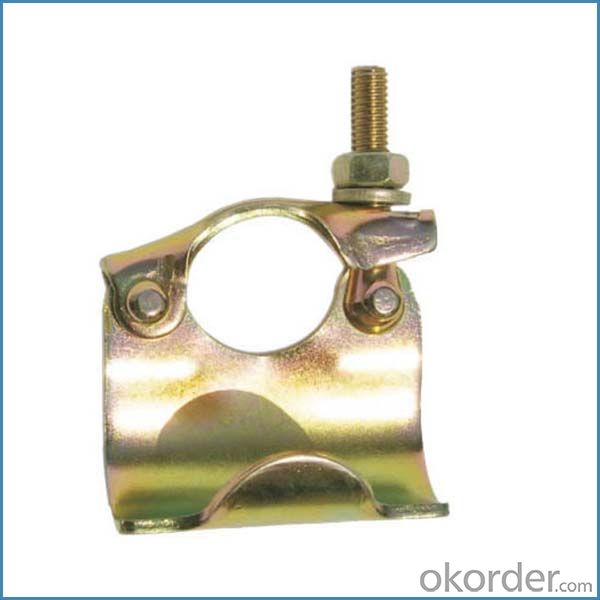
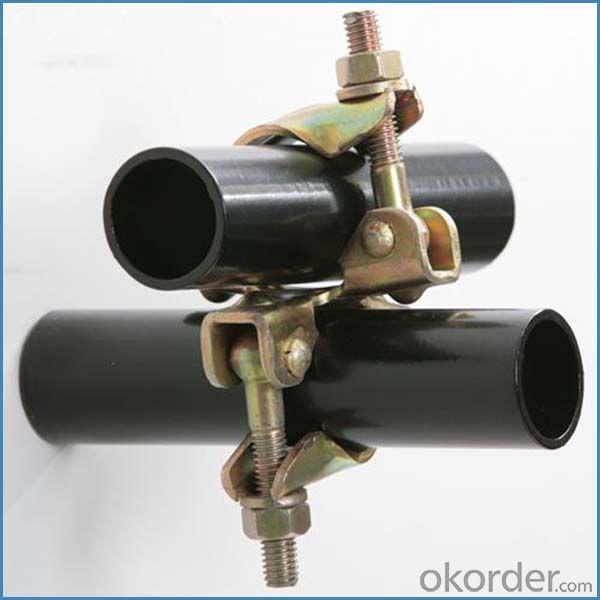
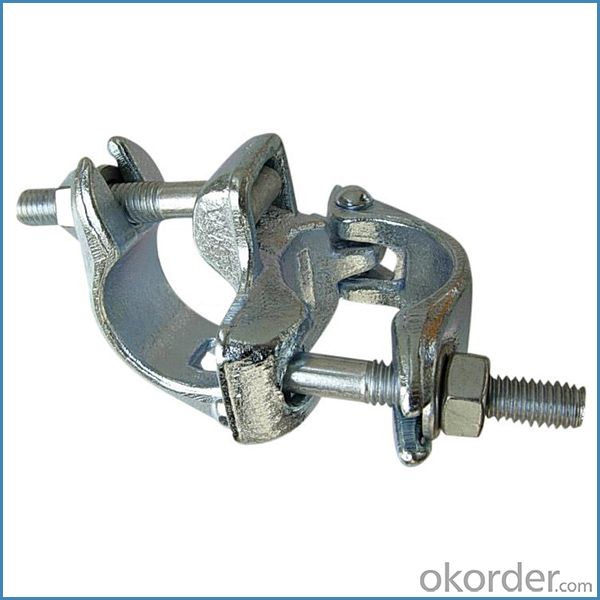
Parameter
| Material | Q235,345steel |
| Size | 48.3mm*48.3mm |
| Surface finish | Galvanized |
| Weight | 1.1kg around |
| Standard | BS1139,EN74 |
| Package | 25pcs/bag,steel pallet |
| Manufacture | As per customer requirement |
| Market | Africa, South America, the Middle East and Asia |
FAQ
Q: Are you a factory or trading company?
We are a state-owned corporation in China,dealing with various kinds of building materials.We have our holding subsidiaries.
Q: Where is your factory located? How can I visit there?
Our factory is located all around China.
Q: Can I get some samples?
Sample is free, customer only pay freight for the first time.
Q: Delivery?
10-30days. (5-15 containers)
Any question,feel free to contact us.
- Q: What are the common applications or industries that utilize steel tube couplers in scaffolding?
- Steel tube couplers are widely used in the construction industry, particularly in scaffolding applications. These couplers play a crucial role in connecting steel tubes together to create a stable and secure scaffolding structure. One of the most common applications of steel tube couplers in scaffolding is in the construction of high-rise buildings. Scaffolding systems are used to provide safe access for workers during the construction process. Steel tube couplers are used to connect the vertical and horizontal steel tubes, creating a strong and stable framework that can withstand the weight of workers, tools, and materials. Another industry that utilizes steel tube couplers in scaffolding is the maintenance and repair sector. Whether it is for painting, cleaning, or fixing, scaffolding is often required to provide access to hard-to-reach areas. Steel tube couplers play a critical role in ensuring the stability and safety of these temporary structures, allowing workers to perform their tasks efficiently and securely. In addition to construction and maintenance, steel tube couplers are also utilized in industries such as shipbuilding, oil and gas, and power plants. These industries often require scaffolding for various purposes, such as ship repairs, maintenance of offshore platforms, or construction of large industrial structures. Steel tube couplers provide the necessary strength and stability to support workers and equipment in these demanding environments. Overall, the common applications and industries that utilize steel tube couplers in scaffolding are construction, maintenance and repair, shipbuilding, oil and gas, and power plants. These couplers are essential components in creating safe and reliable scaffolding structures, ensuring the safety of workers and facilitating efficient work in various industries.
- Q: Are there any weight restrictions for steel tube couplers in scaffolding?
- Weight restrictions apply to steel tube couplers used in scaffolding. These restrictions differ according to the coupler's type, size, and the specific scaffolding system employed. To ascertain the maximum load capacity of the couplers, it is crucial to refer to the manufacturer's guidelines and specifications. Ignoring these weight restrictions may jeopardize the scaffolding's structural integrity and put workers at significant risk. Hence, it is vital to observe the recommended weight limits and guarantee that the scaffolding is correctly designed and assembled to support the intended loads.
- Q: Are there any specific guidelines for the safe use of steel tube couplers in scaffolding near areas with excessive noise or vibrations?
- Indeed, there exist specific guidelines for the secure utilization of steel tube couplers in scaffolding in close proximity to regions with excessive noise or vibrations. When operating in such areas, it is of utmost importance to guarantee the stability and integrity of the scaffold structure. Here are a few recommendations to adhere to: 1. Opt for appropriate steel tube couplers: Carefully select couplers that are specifically designed for scaffolding purposes and have the ability to withstand high levels of noise or vibrations. Ensure that they meet the necessary safety standards and have been approved for usage in such conditions. 2. Perform a risk assessment: Prior to setting up the scaffold, evaluate the levels of noise and vibrations in the area. Identify potential hazards and assess the structural requirements based on these factors. 3. Employ robust scaffolding materials: Choose high-quality steel tubes that can endure excessive noise and vibrations without compromising the scaffold's integrity. Verify that the tubes are in good condition and receive proper maintenance. 4. Secure the connections: Guarantee that all couplers are securely fastened and locked in place. Regularly inspect the connections to detect any indications of loosening or movement caused by noise or vibrations. Strengthen the connections if necessary. 5. Consider additional stabilization measures: In regions with excessive noise or vibrations, it may be necessary to provide additional stabilization to the scaffold. This can involve utilizing diagonal braces or tie-ins to enhance the structure's stability. 6. Train workers and supply appropriate PPE: Educate workers about the potential risks associated with noise and vibrations and provide them with adequate training on safe working practices. Additionally, ensure that workers have access to suitable personal protective equipment (PPE) to minimize exposure to excessive noise or vibrations. 7. Monitor noise and vibration levels: Implement a monitoring system to regularly assess and measure the noise and vibration levels in the vicinity of the scaffold. This will aid in identifying any changes or potential risks that may require adjustments to the scaffold setup. By adhering to these guidelines, scaffolding near areas with excessive noise or vibrations can be securely utilized, ensuring the stability and safety of both the structure and the workers involved.
- Q: Can steel tube couplers be used in scaffolding projects with limited access to anchor points for tie-offs?
- Yes, steel tube couplers can be used in scaffolding projects with limited access to anchor points for tie-offs. Steel tube couplers are commonly used in scaffolding systems to connect tubes together, providing a secure and stable structure. These couplers can be used as anchor points for tie-offs when there are limited options available. By properly securing the couplers to the scaffold tubes using appropriate tie-off techniques, it is possible to create a safe working environment even in situations with limited access to anchor points. However, it is important to ensure that the couplers are rated for the intended load and that all safety regulations and guidelines are followed to guarantee the structural integrity and stability of the scaffolding system.
- Q: Can steel tube couplers be used in complex scaffolding designs?
- Yes, steel tube couplers can be used in complex scaffolding designs. Steel tube couplers are versatile and strong, making them suitable for various scaffolding applications, including complex designs. They provide a secure connection between steel tubes, allowing for the creation of intricate and stable scaffolding structures. The couplers are designed to firmly grip the tubes and can withstand heavy loads, ensuring the safety and stability of the scaffolding system. Additionally, steel tube couplers are easy to install and dismantle, making them a practical choice for complex scaffolding designs that may require frequent adjustments or modifications. Overall, steel tube couplers are a reliable and efficient component for constructing complex scaffolding designs.
- Q: How do steel tube couplers contribute to the overall durability of scaffolding structures?
- Steel tube couplers play a crucial role in enhancing the overall durability of scaffolding structures. These couplers are designed to securely connect steel tubes together, creating a stable framework that can withstand heavy loads and adverse weather conditions. One of the key contributions of steel tube couplers to the durability of scaffolding structures is their ability to provide strong and reliable connections. These couplers are usually made from high-quality steel, which ensures their strength and long-term durability. When properly installed, they create a solid and rigid connection between the tubes, preventing any movement or dislodging that could compromise the stability of the structure. This ensures that the scaffolding can support the weight of workers, materials, and equipment without any risk of collapse. Furthermore, steel tube couplers are designed to distribute the load evenly across the connected tubes. This helps in preventing stress concentration at particular points, which can lead to structural weaknesses and potential failure. By evenly distributing the load, the couplers contribute to the overall strength of the scaffolding structure, making it more resistant to deformation and bending. Another significant contribution of steel tube couplers is their ability to provide versatility and flexibility in scaffolding design. These couplers allow for various configurations and adjustments, enabling scaffolding structures to adapt to different project requirements and site conditions. Whether it is a simple straight structure or a complex arrangement with corners and angles, the couplers ensure that the scaffolding can be easily assembled, disassembled, and reconfigured without compromising its durability. Moreover, steel tube couplers are known for their resistance to corrosion and degradation. They are often coated with protective layers such as galvanization, which prevents rusting and corrosion caused by exposure to moisture and other environmental factors. This improves the longevity of the couplers and, consequently, the overall durability of the scaffolding structure. In conclusion, steel tube couplers contribute significantly to the overall durability of scaffolding structures. Their strong and reliable connections, load distribution capabilities, versatility, and resistance to corrosion help ensure that the scaffolding can withstand heavy loads, adapt to different configurations, and remain stable and secure throughout its lifespan.
- Q: What are the advantages of using steel tube couplers over other types of couplers?
- One advantage of using steel tube couplers over other types of couplers is their strength and durability. Steel tube couplers are made from high-quality steel, making them highly resistant to bending, breaking, and corrosion. Additionally, they offer a secure and reliable connection between two tubes, ensuring structural integrity and safety. Moreover, steel tube couplers are versatile and compatible with various tube sizes, allowing for easy installation and flexibility in construction projects.
- Q: What are the advantages of using steel tube couplers over other types of couplers in scaffolding?
- Using steel tube couplers in scaffolding offers several benefits. Firstly, they are renowned for their strength and durability, guaranteeing a secure connection between scaffolding tubes and the ability to endure heavy loads. This makes them the perfect choice for construction projects that necessitate a stable and dependable structure. Additionally, steel tube couplers are incredibly versatile and can be employed in various configurations. They effortlessly attach to scaffolding tubes of different sizes, granting flexibility in constructing scaffolding systems. This adaptability makes them suitable for a wide array of applications and ensures compatibility with existing scaffolding equipment. Another advantage of steel tube couplers is their user-friendly nature. They boast a straightforward design that facilitates swift and efficient installation. This saves both time and effort during the assembly and disassembly of scaffolding systems, ultimately enhancing productivity on the job site. Furthermore, steel tube couplers exhibit excellent resistance to corrosion. They are frequently galvanized or coated with protective materials to prevent rust and corrosion, guaranteeing their durability in harsh environments. This corrosion resistance renders them a reliable choice for outdoor projects, particularly in areas with high humidity or exposure to the elements. Lastly, steel tube couplers possess a remarkable load-bearing capacity. They can withstand substantial weight without compromising the stability of the scaffolding structure. Consequently, they are well-suited for heavy-duty construction projects that necessitate scaffolding capable of supporting heavy equipment or materials. To summarize, the advantages of utilizing steel tube couplers in scaffolding include their strength, versatility, ease of use, resistance to corrosion, and high load-bearing capacity. These qualities establish them as the preferred choice for construction professionals seeking a reliable and durable coupler option.
- Q: Can steel tube couplers be used in specialized scaffolding projects, such as bridge construction?
- Yes, steel tube couplers can be used in specialized scaffolding projects such as bridge construction. Steel tube couplers are commonly used in scaffolding systems to connect and secure steel tubes together, providing a strong and secure framework. These couplers are designed to withstand heavy loads and provide stability, making them ideal for supporting the weight and structure of bridges during construction. Additionally, steel tube couplers are versatile and can be easily adjusted and dismantled, allowing for easy installation and removal in specialized scaffolding projects. Thus, steel tube couplers are a reliable and efficient choice for bridge construction scaffolding.
- Q: I am thinking about getting one on my left ear what age do you have to be to get one and what precautions are there?
- Typically, the minimum age for all piercings is 18, although it may vary based on where you live. As with all cartridge piercings, you face the risk of developing keloids, which are clumps of scar tissue that form around the piercing. Often, they are treatable, but very ugly. There is also the risk of infection, which can easily be avoided by seeking out reputable piercers and clean shops, and by healthy after care on your end. Also, consider it may often get caught in hair or clothes. Other than that, this is a pretty simple piercing and has rarely caused a problem for anyone who approaches it correctly.
Send your message to us
British Swivel Coupler British Type for Sale
- Loading Port:
- Tianjin
- Payment Terms:
- TT OR LC
- Min Order Qty:
- 100 kg
- Supply Capability:
- 100000 kg/month
OKorder Service Pledge
OKorder Financial Service
Similar products
Hot products
Hot Searches
Related keywords
